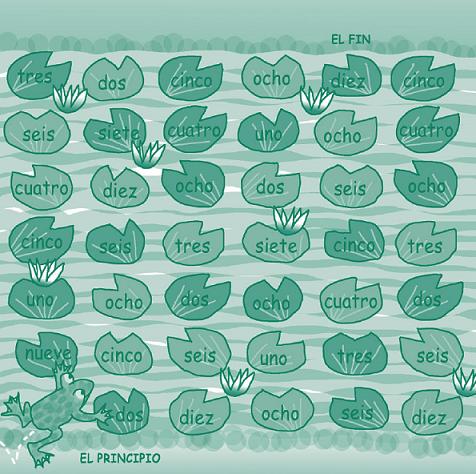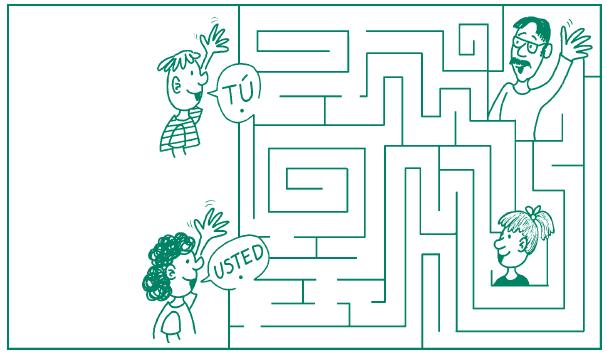
Jumping Numbers
A frog wants to cross the pond, but he can only jump on lily pads with even numbers. Can you help him find the correct path from el principio (the start) to el fin (the end)? Hint: The frog can jump straight ahead, left, or right, but not diagonally.

To practice using the Spanish numbers, go around your house and count how many of the following items you see. Write your answers in the blank spaces. So, for example, if there are five clocks in your house, your response would look like this:
| clocks | cinco
|
| beds | _______________ |
| rugs | _______________ |
| sinks | _______________ |
| televisions | _______________ |
| telephones | _______________ |
| computers | _______________ |
Essential Vocabulary—Vocabulario esencial
When you’re learning a new language, you often need to ask a lot of questions. This is when your essential vocabulary comes into play. This includes all the question and answer words you know in English. Check out the following list, and try pronouncing these essential Spanish words.
| English | Spanish | Pronunciation |
| yes | sí | SEE |
| no | no | NOH |
| I don't know | no sé | no SEH |
| OK | de acuerdo | deh ah KWER doh |
| who | quién | KEE EN |
Consejo
IMPORTANT TIP
| English | Spanish | Pronunciation |
| what | qué | KEH |
| when | cuándo | KWAN doh |
| where | dónde | DON deh |
| why | por qué | por KEH |
| how | cómo | KOH moh |
| and | y | ee |
| or | o | o |
Now try practicing some of these essential Spanish words by answering the following questions. These are “yes or no” questions, so you can answer with either sí or no. Write your answers in the blank spaces.
| Does your family have a pet? | ___________________________ |
| Do you like the color blue? | ___________________________ |
| Do you like to read books? | ___________________________ |
| Have you ever been to the zoo? | ___________________________ |
| Do you enjoy playing sports? | ___________________________ |
Now that you know these essential words, try putting them into sentences. The following are very useful sentences to use when you need to ask questions or get more information.
| English | Spanish | Pronunciation |
| I have a question. | Tengo una pregunta. | TEN goh OO nah preh GOON tah |
| What does _____ mean? | ¿Qué quiere decir _____ ? | keh KEE EH reh deh SEER |
| How do you say _____ in Spanish? | ¿Cómo se dice _____ en español? | KOH moh seh DEE seh _____ en es PAH neeol |
If you need someone to repeat something or speak more slowly, you can try these useful phrases:
| English | Spanish |
| What? | ¿Cómo? |
| I am sorry, I don't understand. | Perdón, no comprendo. |
| Repeat, please. | Puede repetir, por favor. |
| Please, more slowly. | Más despacio, por favor. |
| One more time, please. | Otra vez, por favor. |
Nouns—Nombres
A noun is a person, place, thing, or idea. For example, here are some nouns in English:
• Person: mother, astronaut, Tommy, Mr. Smith
• Place: home, space, Chicago, Ireland
• Thing: book, suit, city, country
• Idea: love, happiness, anger, faith
In Spanish, nouns have what is called “gender,” which means that every noun is either masculine or feminine. When you are talking about people and animals, gender makes sense; some people and animals are masculine (boys, men, lions) and some are feminine (girls, women, lionesses). But for other words, gender can seem funny. For example, cheese is masculine (el queso) and milk is feminine (la leche). But the gender for these nouns is not meant to say cheese is like a boy and milk is like a girl; the gender is just part of the name of each word.
Now, here are some common nouns and their translations in Spanish. Pay attention to the words el and la that come before each Spanish noun.


¡CUIDADO!
Mistake to Avoid
Here are some words that end in a but are masculine: el clima (climate), el día (day), el fantasma (ghost), el idioma (language), el mapa (map), el planeta (planet), el problema (problem), el sofá (sofa). There are fewer words that end in o but are feminine; for example, la mano (hand).
| English | Spanish | English | Spanish |
| the father | el padre | the mother | la madre |
| the boy | el chico | the girl | la chica |
| the cheese | el queso | the milk | la leche |
| the love | el amor | the happiness | la felicidad |
El and la are called “definite articles” and are used when you want to talk about a specific noun. For example, “The book is on the table.” You are talking about a specific book and a specific table, so you use the definite articles: El libro está sobre la mesa.
Un and una are called “indefinite articles” and are used when you are not talking about a specific noun. For example, “Do you have a hat and a scarf?” You are asking whether the person has one of these, so you use the indefinite articles: ¿Tienes un sombrero y una bufanda?
Besides gender, Spanish nouns also have “number.” This is easier because it’s just like in English: nouns are either singular (just one) or plural (more than one). Spanish has special definite articles and indefinite articles for plural nouns. For example:
| English (singular) | Spanish (singular) |
| the father | el padre |
| a father | un padre |
| the mother | la madre |
| a mother | una madre |
| English (plural) | Spanish (plural) |
| the fathers | los padres |
| some fathers | unos padres |
| the mothers | las madres |
| some mothers | unas madres |
Verbs—Verbos
A verb is an action word: It says what is happening or how something is. Here are some verbs you already know in English:
• to do
• to go
• to want
• to listen to
• to be
• to play
• to hope
Verbs have many different forms, called “conjugations.” Verbs change depending on whether the action is in the present, past, or future, and they also change depending on who is doing the action or being a certain way. For example:
I am going to the store.
You eat a lot.
He walks every day.
The words I, you, he, she, we, and they are called “subject pronouns.” Here are Spanish subject pronouns with their pronunciations:
¡CUIDADO!
Mistake to Avoid
There are four words for “you” in Spanish. There are different words for “you” when talking to a friend or to an adult: tú is used when you talk to a friend and usted (often abbreviated Ud.) is used when you talk to an adult. Then there are also plurals that are used in different countries. For example, you use vosotros when you are talking to more than one friend in Spain, and ustedes (abbreviated Uds.) when you are talking to more than one adult in Spain, or to a group of people, friends and adults alike, in Spanish-speaking countries besides Spain.
| English | Spanish | Pronunciation |
| I | yo | YOH |
| you | tú | TOO |
| you all | ustedes/vosotros | ooS TEH dehs/boh SOH tros |
| you (formal) | usted | oo STED |
| you (formal, plural) | ustedes | oo STED es |
| he | él | EHL |
| she | ella | EH ya |
| we | nosotros | noh SOH tros |
| they (masculine, mixed gender) | ellos | EH eeos |
| they (feminine) | ellas | EH eeas |
Hey
You!
One kid is talking to an adult teacher, while the other is talking to a cousin the same age. Start at the dot under each word. Follow the maze to find out who is talking to whom!

Conjugations are very important. In Spanish, the conjugation is different for every person doing the action, which means that you can actually leave out the subject pronoun, because the verb tells you who is doing the action. For example:
| English | Spanish | Spanish (without subject pronoun) |
| I am going to the store. | Yo voy al mercado. | Voy al mercado. |
| You are going to the store. | Tú vas al mercado. | Vas al mercado. |
| He is going to the store. | Él va al mercado. | Va al mercado. |
Each time you learn a new verb, you have to learn how it is conjugated. But this is not as difficult as it sounds because many verbs follow the same patterns for conjugation. All verbs end in -ar, -er, or -ir, and this ending determines how they will be conjugated. For example, hablar (to speak) is an -ar verb.
| English | Spanish |
| I speak | yo hablo |
| you speak | tú hablas |
| he speaks | él habla |
Some other common -ar verbs are amar (to love), ayudar (to help), lavar (to wash), and pagar (to pay).
Comer (to eat) is an -er verb.
| English | Spanish |
| I eat | yo como |
| you eat | tú comes |
| he eats | él come |
Here are a few more -er verbs: aprender (to learn), beber (to drink), deber (to have to), and leer (to read).
Abrir (to open) is an -ir verb, and -ir verbs are conjugated just like -er verbs.
| English | Spanish |
| I open | yo abro |
| you open | tú abres |
| he opens | él abre |
Some useful -ir verbs are: asistir (to attend), describir (to describe), escribir (to write), vivir (to live).
Some verbs are irregular, which means that they don’t follow these conjugation patterns. You’ll learn how to conjugate the most common irregular verbs later in this book.

¿Cómo?—
Say What?
Pronunciation and Spelling—
Pronunciación y ortografía
Pronunciation means the way that you say a word. Spanish pronunciation is very easy. In fact, it’s easier than English pronunciation, because Spanish does not have lots of silent letters and all kinds of different sounds for each vowel. Spanish has one sound for each vowel:
| Vowel | Pronunciation |
| A | “ah” like in “father” |
| E | “eh” like in “bed” |
| I | “ee” like in “meek” |
| O | “oh” like in “go” |
| U | “oo” like in “moon” |
Most of the consonants are very easy too:
| Consonant | Pronunciation |
| B and V | like the b in “boy” |
| D | like the d in “do” |
| F | like the f in “father” |
| K and Q | like the k in “kite” |
| L | like the l in “live” |
| M | like the m in “mother” |
| N | like the n in “no” |
| P | like the p in “put” |
| S and Z | like the s in “see” |
| T | like the t in “take” |
| W (rare in Spanish) | like the w in “water” |
| Y | like the y in “yes” |
The rest of the Spanish letters are different than the English ones, but with a little practice they are very easy too.
| Letter | Pronunciation |
| H | always silent |
| Ñ | like the ni in “onion” |
| J | sound does not exist in English, but the closest sound is like the h in “hello” |
| R | sound does not exist in English; this is called a “rolled r” because it's pronounced by letting your tongue roll against your teeth. |
| C and G | When C is followed by A, O, U, or a consonant, it is pronounced like the c in “cat.” When C is followed by E or I, it is pronounced like the c in “cell.” When G is followed by A, O, U, or a consonant, it is pronounced like the g in “give.” When G is followed by E or I, it is pronounced like the Spanish J. |
| X | Sometimes it is pronounced like the x in “tax.” Other times, it is pronounced like the x in “exist.” |
Pronunciation and spelling are much more closely related in Spanish than in English. The only Spanish letters that cause any real problems with spelling are H (because it’s silent) and B and V (because they sound the same). Other than those, what you hear is what you write. Compared to English, with silent letters at the beginning of words (like the K in “knife”), in the middle of words (like the G in “sign”), and at the end of words (like the B in “lamb”), Spanish pronunciation is a piece of cake!
Consejo
IMPORTANT TIP
Now that you’ve learned a little bit about pronunciation, it’s time to try speaking some Spanish aloud! Grab a parent or friend and ask if he or she would like to practice with you. Then take turns saying each of the following words aloud. Use the hints if you forget how to pronounce a letter.
| Spanish | English | Pronunciation Hint |
| pollo | chicken | ll sounds like the English “y” |
| verde | green | v sounds like “b” |
| sueño | dream | ñ sounds like “ni” in “onion” |
| queso | cheese | qu sounds like the “k” in “kite” |
| joya | jewel | j sounds like the English “h” |
| hora | hour | h is silent |
Now that you’ve had practice saying these words aloud, try having a little conversation with your parent or friend. You can use some of these same words to create a silly conversation using both English and Spanish. Here’s an example:
Jane: Hi, Billy.
Billy: Hello.
Jane: Do you like pollo?
Billy: Yes! I especially like it with queso.
Jane: Me too. What’s your favorite color?
Billy: I really like verde.
Jane: Wow! That’s the color of the joya in my necklace.
Now use some of these words to write your own silly Spanish-and-English conversation:
